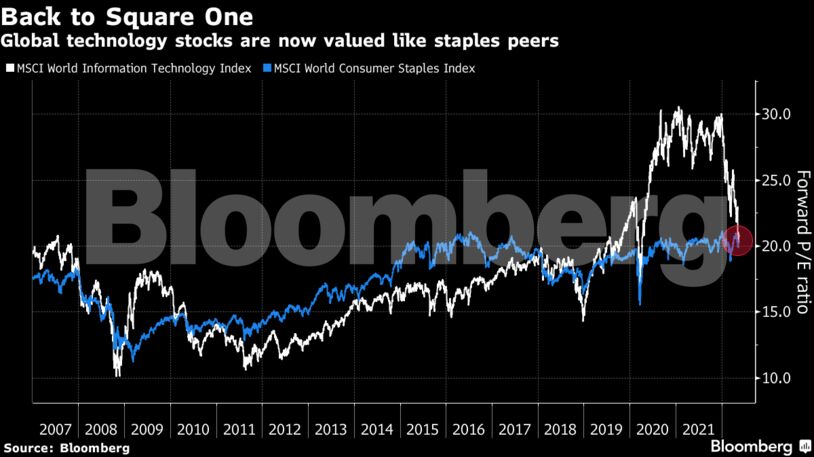Treasuries rose across the board, sending the 10-year Treasury yield 6 basis points lower. The dollar rose against all of its Group-of-10 counterparts, except the yen and Swiss franc.
The benchmark S&P 500 is emerging from the longest weekly slump since 2011, but rebounds in risk sentiment are proving fragile amid tightening monetary settings, Russia’s war in Ukraine and China’s Covid lockdowns.

In some of his most hawkish remarks to date, Federal Reserve Chair Jerome Powell said Tuesday that the US central bank will raise interest rates until there is “clear and convincing” evidence that inflation is in retreat. Chicago Fed President Charles Evans said Wednesday he sees a half-point rate increase at next month’s meeting and “probably thereafter.”
Commentary
- “We are pricing in a growth scare,” Lori Calvasina at RBC Capital Markets told Bloomberg TV. “The market is trying to find a bottom here. There is a lot of uncertainty in this market right now about whether or not that recession is going to come through or if it’s going to be another near-death experience.”
- “The threat to asset prices is broad-based inflation pushing central banks to tighten monetary policy even more rapidly,” Carl Ludwigson at Bel Air Investment Advisors said in a note. “If the Federal Reserve’s policy response proves too aggressive, then Treasuries and high-quality municipal bonds will again be the place to hide as tighter financial conditions lead to demand destruction.”
In Europe, new-vehicle sales shrank for a 10th month in a row as the industry remains mired in supply-chain crises, while euro-area inflation plateaued at a record high. Meanwhile, UK inflation rose to its highest level since Margaret Thatcher was prime minister 40 years ago, adding to pressure for action from the government and central bank.
Elsewhere, the Biden administration is poised to fully block Russia’s ability to pay US bondholders after a deadline expires next week, a move that could bring Moscow closer to a default. Sri Lanka, meantime, is on the brink of reneging on $12.6 billion of overseas bonds, a warning sign to investors in other developing nations that surging inflation is set to take a painful toll
What damage will be done to the US economy and global markets before the Fed changes tack and eases policy again? The “Fed Put” is the theme of this week’s MLIV Pulse survey. Click here to participate anonymously.
What to watch this week:
- G-7 finance ministers and central bankers meeting Wednesday
- Philadelphia Fed President Patrick Harker speaks Wednesday
- China loan prime rates Friday
Some of the main moves in markets:
Stocks
- The S&P 500 fell 2.6% as of 11:24 a.m. New York time
- The Nasdaq 100 fell 3%
- The Dow Jones Industrial Average fell 2.3%
- The Stoxx Europe 600 fell 1.1%
- The MSCI World index fell 1.7%
Currencies
- The Bloomberg Dollar Spot Index rose 0.2%
- The euro fell 0.5% to $1.0494
- The British pound fell 0.7% to $1.2400
- The Japanese yen rose 0.8% to 128.33 per dollar
Bonds
- The yield on 10-year Treasuries declined seven basis points to 2.92%
- Germany’s 10-year yield declined three basis points to 1.02%
- Britain’s 10-year yield declined two basis points to 1.86%
Commodities
- West Texas Intermediate crude fell 1.8% to $110.36 a barrel
- Gold futures fell 0.3% to $1,813.90 an ounce
–With assistance from Michael Msika, Andreea Papuc, Robert Brand and Isabelle Lee.


















Comments - Please login in order to comment.